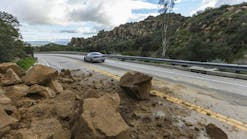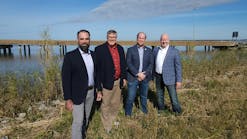Shorefront Protection on Cape Cod
Located near the “elbow” of Cape Cod, the small town of Orleans, MA, is bordered on the east by the Atlantic Ocean and on the west by Cape Cod Bay. It is home to some 6,000 residents.
The property of one of those residents had suffered a substantial streambank collapse, and the owner called in local Coastal Engineering Co. to help. Roger Michniewicz, manager of the Marine Division of the company, describes the situation.
“It was a shorefront site on Cape Cod. It had a previous coconut-fiber roll shorefront protection system put in about 18 years ago. It was covered over in sand and earth material, and planted over. The previous system lasted many, many years—well beyond its expected timeline. But by now, it was essentially completely disintegrated, other than the synthetic netting.
The owner was interested in a similar system. “The product has been improved,” notes Michniewicz. “Those coconut-fiber rolls are packed really, really tightly. I believe they are now 20-inch-diameter rolls. The previous installation used 12-inch-diameter fiber rolls. They were stacked four or five rolls high, for a length of 100 feet or so, on a sloped angle of about 40 to 45 degrees. This was against the eroding toe of a vegetated embankment that had trees and other vegetation above.
“Due to storms, there was some scarping in that area. The system worked well for all those years, which is highly unusual. However, it is a somewhat benign location as far as susceptibility to erosion by storms.”
Perhaps due to the surprising success of the previous installation, Michniewicz decided to use a similar solution. The construction management firm NETCO, based in Lexington, MA, was selected to be the installation contractor for the job.
“This system was put in to pretty much match what was done previously, although we used larger coconut fiber logs,” says Michniewicz. “The previous system was actually held in place by a system of rope cable that went around the fiber rolls, and then they were attached to small helical piles. In those early days, these were actually agricultural items, and they have a 5-inch-diameter corkscrew blade. The shaft was of about a half-inch diameter with a loop at the end to attach a cable or a rope. These were then twisted into the ground, and they were probably around 40 inches long.
“For example, these might be used if you were planting a sapling tree, and you wanted to hold it down to an anchor from three sides. So this was really an agricultural landscaping product that was jerry-rigged to a system holding these fiber rolls against the embankment. There were a number of them.
“Nowadays, these helical piles are much more robust, more heavy duty. What we found on this particular application, however, was that after we cleared away debris, those helical anchors were still intact and still usable. They didn’t exhibit much corrosion, even being in this marine environment. So we were able to utilize those in the installation of the new fiber rolls. We tied the new fiber roll system to the embankment using the previously installed helical tiebacks.
“Our installation, like the previous installation, was covered with a foot or so of sandy soil, and this was planted with Native American beachgrass. This was put in to develop a root system that would help tie everything together and hold the soil together. For this particular location, it worked very well.”
Today, the coir logs can’t even be seen. Occasional maintenance, however, is required.
“Storms may, from time to time, remove surface materials,” explains Michniewicz. “Usually, the document from the conservation commission, called the order of conditions, mandates that you maintain them and keep them covered. Typically, the owner will want to do this, because the coconut-fiber rolls are organic and biodegradable, and susceptible to ultraviolet degradation when exposed to the atmosphere. So you want to keep these fiber logs covered, to extend their lifetime.”
Michniewicz notes that the type of work that was done on this project is very heavily regulated. Getting the necessary approvals can be a difficult task.
“There can be a little confusion among the public regarding why we are even putting in something biodegradable. It comes down to what’s allowed by environmental regulations, which are very comprehensive, especially in Massachusetts. It determines what is protectable and what is not protectable.”
Not only are projects such as this one regulated under the Massachusetts Wetland Protection Act, he says, but “virtually all towns in Massachusetts have enacted their own wetland protection bylaws. When we do a filing, we have to file for permission under two entities. The local conservation commissions have a tremendous amount of control. For this particular installation, only a soft solution for erosion control was allowed, not a rock revetment or a vinyl or wood bulkhead.
“Also, the permittability of these systems varies considerably from town to town, even in a region like Cape Cod. It’s based upon the feelings and philosophies of the conservation commission members who happen to be sitting on the commission at the time.”
So even though some of these “soft” solutions may not hold up as well under all conditions, property owners may well be limited in their options.
Michniewicz points out another important issue that property owners must be aware of when implementing erosion and sediment control measures. “The state Wetland Protection Act and other regulations recognize that erosion of certain areas is a natural process that provides sediment to other areas, such as coastal beaches and dunes. We’re armoring for protection of property and structures, although in doing so, we’re inhibiting the free, natural movement of material.
“When we work on these projects, we have to be cognizant of this loss of material. So most commissions require that if you armor, you also have to provide a sediment source on a regular basis. You may have to come back perhaps once a year to provide an estimate of what would have been the volume of sediment that would have left the site annually, by way of erosion, to continue on down the beach. Then you have to place an equivalent amount of a compatible-grain-size sand on the site, on an annual basis, to make up for the loss of sediment that otherwise would have reached the area.
“So we’re always playing a game of armoring—preventing erosion for one purpose—but the owners, through these conservation commissions, are required to provide augmentation, knowing that it will be washed away on a regular basis.”
So simply protecting one’s property from erosion can create new obligations for years to come.
“That’s part of the approval process. An issue also becomes, post-construction, how do you get the material there, year after year? An arrangement may need to be made for provisional access to a particular site. It can be cumbersome. But it is a requirement.”
Michniewicz was pleased with the work NETCO, the installation contractor, did with this property.
“On this project, we went through permitting, produced the plans, and then assisted the homeowner to put the project out to bid with a half dozen potential contractors. In this particular case, NETCO was the successful bidder.
“They are a very successful company, because they work on an awful lot of projects throughout New England.”






